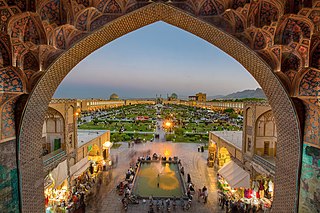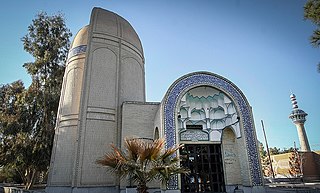Iranian Georgians are Iranian citizens who are ethnically Georgian, and are an ethnic group living in Iran. Today's Georgia was a subject to Iran from the 16th century till the early 19th century, starting with the Safavids in power. Shah Abbas I, his predecessors, and successors, relocated by force hundreds of thousands of Christian, and Jewish Georgians as part of his programs to reduce the power of the Qizilbash, develop industrial economy, strengthen the military, and populate newly built towns in various places in Iran including the provinces of Isfahan and Mazandaran. A certain amount, amongst them members of nobility, also migrated voluntarily over the centuries, as well as some that moved as muhajirs in the 19th century to Iran, following the Russian conquest of the Caucasus. The Georgian community of Fereydunshahr have retained their distinct Georgian identity until this day, while having to adopt aspects of Iranian culture such as the Persian language and Twelver Shia Islam.

Shahr-e Rey or simply Ray is the capital of Ray County in Tehran Province, Iran. Formerly a distinct city, it has now been absorbed into the metropolitan area of Greater Tehran as the 20th district of municipal Tehran, the capital city of the country.

Isfahan, historically also rendered in English as Ispahan, Sepahan, Esfahan or Hispahan, is a city in Iran. It is located 406 kilometres south of Tehran, and is the capital of Isfahan Province.

The Golestan Palace is the former royal Qajar complex in Iran's capital city, Tehran.

Fin Garden located in Kashan, Iran, is a historical Persian garden. It contains Kashan's Fin Bath, where Amir Kabir, the Qajarid chancellor, was murdered by an assassin sent by King Nasereddin Shah in 1852. Completed in 1590, the Fin Garden is the oldest extant garden in Iran.

Iranian architecture or Persian architecture is the architecture of Iran and parts of the rest of West Asia, the Caucasus and Central Asia. Its history dates back to at least 5,000 BC with characteristic examples distributed over a vast area from Turkey and Iraq to Uzbekistan and Tajikistan, and from the Caucasus to Zanzibar. Persian buildings vary from peasant huts to tea houses, and garden pavilions to "some of the most majestic structures the world has ever seen". In addition to historic gates, palaces, and mosques, the rapid growth of cities such as the capital Tehran has brought about a wave of demolition and new construction.

Naqsh-e Jahan Square, also known as Imam Square, is a square situated at the center of Isfahan, Iran. Constructed between 1598 and 1629, it is now an important historical site, and one of UNESCO's World Heritage Sites. It is 160 metres (520 ft) wide by 560 metres (1,840 ft) long. It is also referred to as Imam Square. The square is surrounded by buildings from the Safavid era. The Imam Mosque is situated on the south side of this square. On the west side is the Ali Qapu Palace. Sheikh Lotf Allah Mosque is situated on the eastern side of this square and at the northern side Qeysarie Gate opens into the Isfahan Grand Bazaar. Today, Namaaz-e Jom'eh is held in the Imam Mosque.

Goharshad Mosque is a grand congregational mosque built during the Timurid period in Mashhad, Razavi Khorasan Province, Iran, which now serves as one of the prayer halls within the Imam Reza shrine complex.

Ali Qapu Palace or the Grand Ālī Qāpū is an imperial palace in Isfahan, Iran. It is located on the western side of the Naqsh-e Jahan Square, opposite to Sheikh Lotfollah Mosque, and had been originally designed as a vast portal entrance to the grand palace which stretched from the Naqsh-e Jahan Square to the Chahar Baq Boulevard. The palace served as the official residence of Persian Emperors of the Safavid dynasty. UNESCO inscribed the Palace and the Square as a World Heritage site due to its cultural and historical importance. The palace is forty-eight meters high and there are six floors, each accessible by a difficult spiral staircase. In the sixth floor, Music Hall, deep circular niches are found in the walls, having not only aesthetic value, but also acoustic. Ālī Qāpū is regarded as the best example of Safavid architecture and a symbol of Iran's Islamic heritage.

The arts of Iran are one of the richest art heritages in world history and encompasses many traditional disciplines including architecture, painting, literature, music, weaving, pottery, calligraphy, metalworking and stonemasonry. There is also a very vibrant Iranian modern and contemporary art scene, as well as cinema and photography. For a history of Persian visual art up to the early 20th century, see Persian art, and also Iranian architecture.

The East-Azerbaijan Provincial Palace is the main office for Iran's East-Azerbaijan provincial governor in downtown Tabriz. The history of the palace goes back to the Safavid and Zand dynasties, when it was named Aali Qapou. The original construction of the palace was supervised by Najaf Qoli Khan for the Safavid kings, when Tabriz was the capital of Iran. During the Qajar era, Aali Qapu served as the residence for the crown prince of Iran. It was reconstructed and repaired under Naser al-Din Shah, during which its name was changed to Shams ol-Emareh. Since the Iranian Constitutional Revolution, the palace has been used as the provincial governorship office.

Iranian Armenia (1502–1828) refers to the period of Eastern Armenia during the early-modern and late-modern era when it was part of the Iranian empire. Armenians have a history of being divided since the time of the Byzantine Empire and the Sassanid Empire, in the early 5th century. While the two sides of Armenia were sometimes reunited, this became a permanent aspect of the Armenian people. Following the Arab and Seljuk conquests of Armenia, the western portion, which was initially part of Byzantium, became eventually part of the Ottoman Empire, otherwise known as Ottoman Armenia, while the eastern portion became and was kept part of the Iranian Safavid Empire, Afsharid Empire and Qajar Empire, until it became part of the Russian Empire in the course of the 19th century, following the Treaty of Turkmenchay of 1828.

Emamzadeh Esmaeil and Isaiah mausoleum is a historical complex in Isfahan, Iran, which dates back to the Seljuk and Safavid era. This complex is located near the Jameh Mosque of Isfahan, in the Hatef street and contains two mausoleums, one believed to be for Esmaeil, one of grandsons of Hasan ibn Ali, and another which is believed to be Isaiah's.

Takht-e Foulad(Persian: تخته فولاد) is a historical cemetery in Isfahan, Iran. The cemetery is at least 800 years old. In the 13th century in the Ilkhanid era Takht-e Foulad was the most important cemetery in Isfahan and all of the famous personalities have a mausoleum in this cemetery. Unfortunately all of the mausoleums from the Ilkhanid era, except Baba Rokn ed-Din mausoleum, which is the oldest structure in Takht-e Foulad, have been destroyed. In the Safavid era there were 400 mausoleums in Takht-e Foulad, but there are now only 8 mausoleums from the Safavid era. In the Qajar era a large part of the cemetery was destroyed, but the cemetery hasn't lost its importance and by the end of Pahlavi era it was the most important cemetery in Isfahan. There are 20 structures from the Qajar era and 17 structures from the Pahlavi era in the cemetery. Before the Safavid age the cemetery had been known as Lessan ol-Arz and Baba Rokn ed-Din, but from the Safavid age until now its name is Takht-e Foulad.

The Museum of Contemporary Art is a contemporary art museum in Isfahan, Iran, located next to the Museum of Natural History.

The Jameh Mosque of Khozan is a historical mosque in the Khomeyni Shahr County of the Isfahan Province. The original building of the mosque dated back to the Timurid era in the 15th century, but it's improbable that the current building to be older than the Safavid era. The mosque has four iwans. The southern iwan leads to the inner space of the dome. The inner space of the dome is decorated by muqarnas. The walls of the mosque are covered by stones and bricks. The arches of the northern and southern iwans are decorated with some paintings from the Safavid era., but the paintings of the eastern and western iwans seem to belong to the Qajar era. The shabestan of the mosque is behind the western iwan. There are 20 stone columns with the height of 2 m in the shabestan. The shabestan had been lit originally with the marble stones of the ceiling, but during the recent reparations, these marble stones have been removed.

The Jalali castle is located in Kashan, Iran.

The Meydan mosque is a historical mosque in Kashan, Iran. It is located in the southern side of the Sang-e Ghadimi square and beside the Bazaar of Kashan. It is one of the oldest structures in Kashan. The primary structure belonged possibly to the seljuq era, but it was destroyed by the Mongols during their invasions. Later it was rebuilt and repaired by Khaje Emad ed-Din. A quotation for this matter is an inscription in the old mihrab, in which it is mentioned that it is built in 623 Hijri by Hassan ebn-e Arabschah in Kashan. The mihrab was in its original place until the last century, but it is kept now in the Museum of Islamic art in Berlin.
The terms People of the Caucasus and Caucasian people indicate two main groups of people in Iran:

Deir-e Gachin Caravansarai is one of the greatest caravansarais of Iran which is located in the center of Kavir National Park. Its unique qualities is the reason it is called “Mother of Iranian Caravansarais”. It is located in the Central District of Qom County, 80 kilometers north-east of Qom and 35 kilometers south-west of Varamin. This monument was registered in Iran's National Heritage List on September 23, 2003. The structure of this caravanserai belongs to Sasanian era, and restorations took place in Seljuk, Safavid and Qajar eras. Its current form belongs to Safavid era. This caravanserai is situated on the ancient rout from Ray to Isfahan.



















